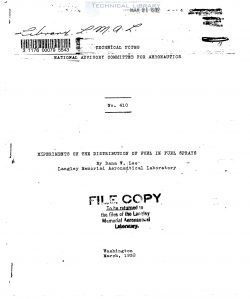naca-tn-410
- Version
- 156 Downloads
- 1.26 MB File Size
- 1 File Count
- November 24, 2016 Create Date
- November 24, 2016 Last Updated
National Advisory Committee for Aeronautics, Technical Notes - Experiments on the Distribution of Fuel in Fuel Sprays

The distribution of the fuel in sprays for compres—
sion—ignition engines was investigated by taking high—
speed spark photographs of fuel sprays produced under a
wide variety of conditions, and also by injecting them
against pieces of Plasticine. A photographic study was
made of sprays injected into evacuated chambers, into the
atmosphere, into compressed air, and into transparent liq—
uids. Pairs of identical sprays were injected counter-to
each other and their behavior analyzed. Small high—veloc—
ity air jets were directed normally to the axes of fuel
sprays, with the result that the envelope of spray which
usually obscures the core was blown aside, leaving the
core exposed on one side.
The results showed that the distribution of the fuel
within the sprays was very uneven. Under engineeoperating
conditions the fuel was subdivided into many small parti-
cles by the time it had penetrated 0.75 inch. In the cores
of the sprays, these particles had a high velocity relative
to the air in their immediate vicinity, but as their veloc~
ity was reduced, they were forced out of the core and formed
the spray envelope. The shape of,the central core varied
with the density of the chamber air, becoming shorter and
thicker with increasing air density.
Because of the great importance of fuel distribution
in the develOpment of light—weight compression—ignition en-
gines, this series of experiments was undertaken for the
purpose of obtaining more information on the distribution
of the fuel within fuel sprays for this type of engine.
There are two general methods aVailable for such an inves-
tigation: the separation of the sprays into parts, fol—
lowed by a determination of the amounts of fuel in each
part, and the high—speed photography of sprays produced
under cenditions especially arranged to reveal -.the de-
sired information. The first'method- -has been success~
fully used at the Pennsylvania State College with sprays
from plain cylindrical nozzles (referenc-es l and 2). and
the results showed that the fuel concentration was great— '
est in the center of the spray. Many early spark photo—
graphs made by the National AdVisory Committee for Aero—
nautics also showed this to be true; but the density of
the spray cloud was so great that little could _be learned
of the internal structure of- the sprays.
In the present experiments, the photographic method
was extended and improved by decreasing the exposure time,
and by injecting the fuel under conditions which had not
been used before at this laboratory. These experiments
were conducted during the. summer of 1931 by the National
Advisory Committee for Aeronautics at Langley Field, Va.
| File | Action |
|---|---|
| naca-tn-410 Experiments on the Distribution of Fuel in Fuel Sprays.pdf | Download |

Comment On This Post